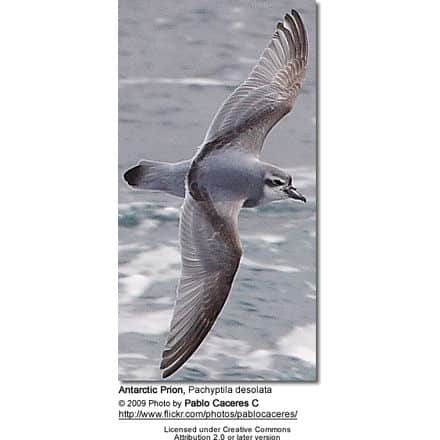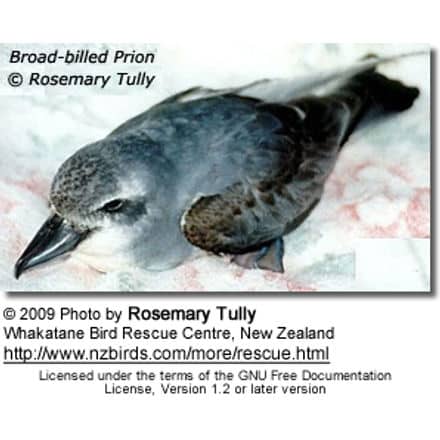Pachyptila or Prions
Pachyptila is a genus from the family Procellariidae and the Procellariiformes order. The members of this genus and the Pachyptilas form a sub-group called Prions.
Etymology
Pachyptila, the word, comes from the Greek words pakhus and ptilon. Pakhus means thick or stout and ptilon means a feather. Also from the Greek language, Prion comes from the word priōn meaning a saw, which is in reference to the serrated edges of its bill.
Taxonomy
All the members of this genus, along with the rest of the Procellariiformes, share certain identifying features.
First, they have nasal passages that attach to the upper bill called naricorns.
Although the nostrils on the Albatross are on the sides of the bill. The bills of Procellariiformes are also unique in that they are split into between 7 and 9 horny plates.
They produce stomach oil made up of wax esters and triglycerides that are stored in the proventriculus (stomach). This is used against predators as well as an energy-rich food source for chicks and for adults during their long flights.
Finally, they also have a salt gland that is situated above the nasal passage and helps desalinate their bodies, due to the high amount of ocean water that they imbibe. It excretes a high saline solution from their nose.
Species
- Pachyptilas turtur, Fairy Prion, breeds on subtropical and subantarctic islands
- Pachyptilas belcheri, Slender-billed Prion, breeds on Crozet Islands, Kerguelen Islands, Falkland Islands, and Noir Island
- Pachyptilas crassirostris, Fulmar Prion
- Pachyptila crassirostris crassirostris, breeds on Snares Islands, Bounty Island, and Chatham Islands
- Pachyptila crassirostris eatoni, breeds on Heard Island and the Auckland Islands
- Pachyptila vittata, Broad-billed Prion, breeds on islands near New Zealand and the Tristan da Cunha group
- Pachyptila desolata, Antarctic Prion
- Pachyptila desolata desolata, breeds Crozet Islands, Kerguelen Islands, and Macquarie Island
- Pachyptila desolata altera, breeds on Heard Island and Auckland Island
- Pachyptila desolata banksi, breeds on the Scotia Archipelago, South Georgia, South Sandwich Islands, and Scott Island
- Pachyptila salvini, Salvin’s Prion
- Pachyptila salvini salvini, breeds on Prince Edwards Islands and Crozet Islands
- Pachyptila salvini Macgillivrayi, breeds on Amsterdam Island and St Paul Island
Behavior
The members of this genus primarily eat zooplankton by filtering water through their upper bill.
Some even hydroplane, a technique where they filter food out while flying with their bill in the ocean.
They breed colonially and do so neat the ocean, usually with the same mate for life. Both sexes help incubate the egg and care for the chick.
Range and habitat
They are pelagic (over sea) and seldom come to land, except to breed. Also, they all stay in the Southern Hemisphere and breed on subantarctic islands except the Fairy Prion which breeds on subtropical islands.






